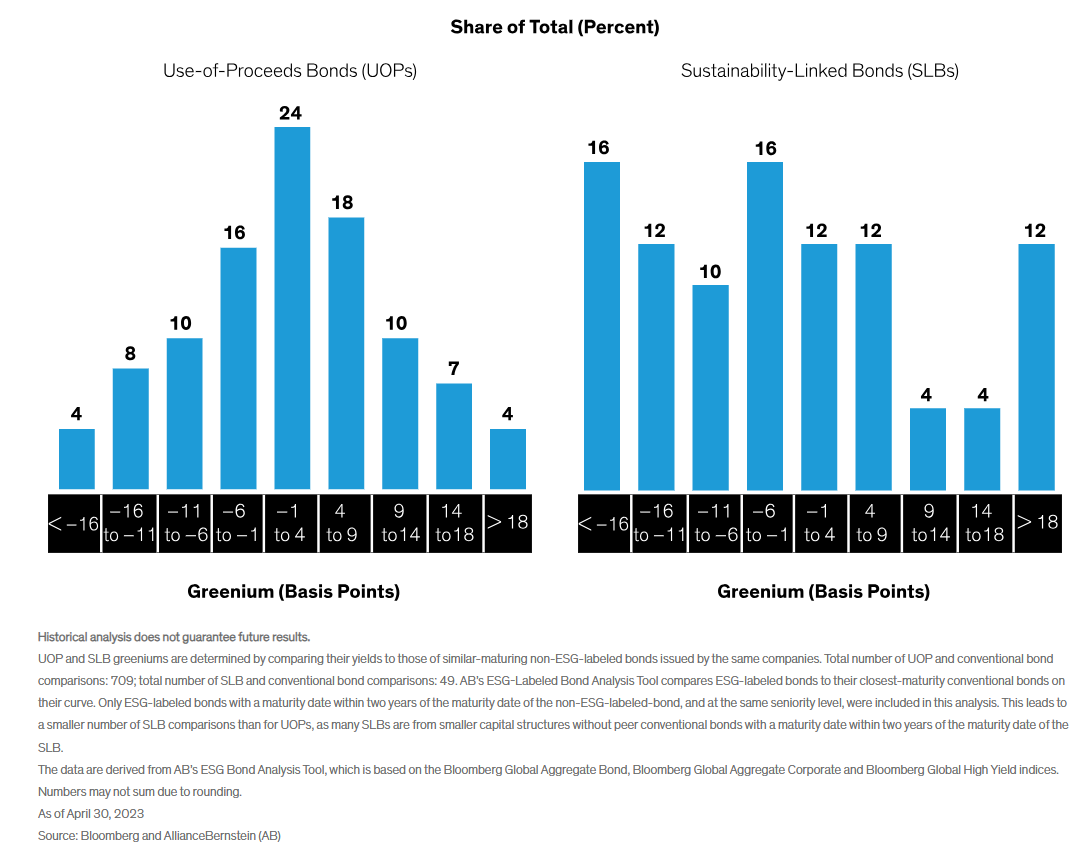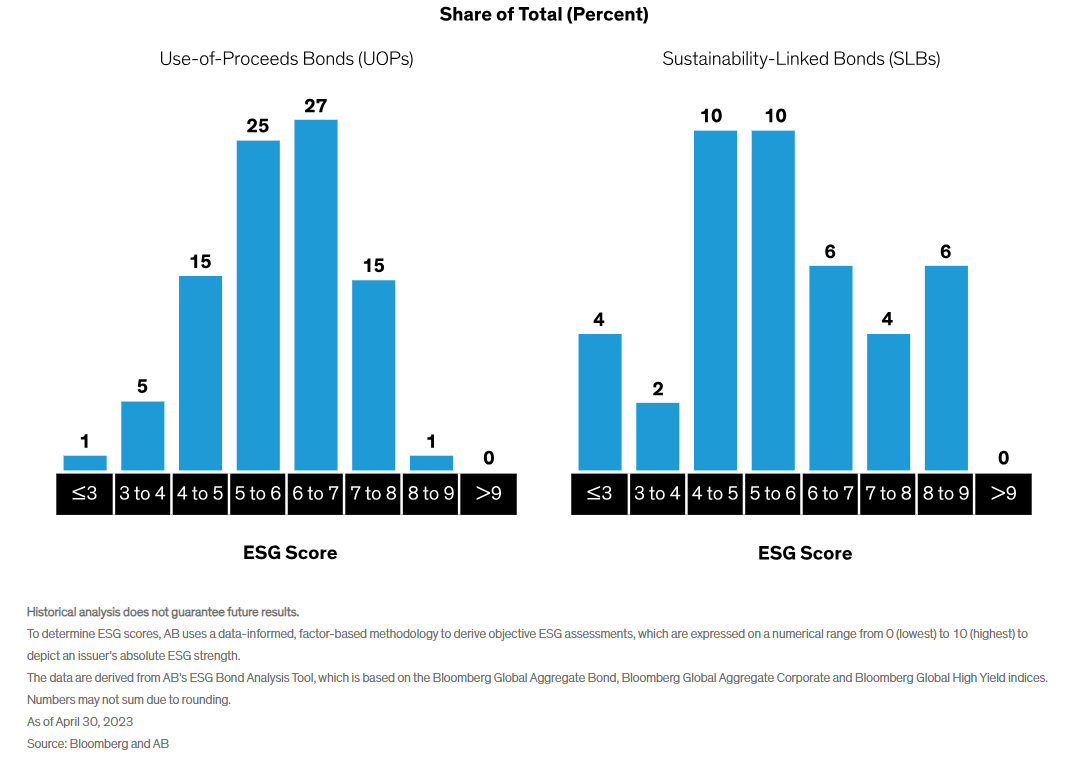Written by: Patrick O'Connell, CFA | Tiffanie Wong, CFA | Markus Peters
Corporate bonds that fund environmental, social and governance (ESG) initiatives continue to capture investor hearts and minds. But ESG-labeled bonds come in different stripes, so investors need to discern among the good, the bad and the occasional ugly ones merely posing as ESG bonds.
Two types in particular offer bookend examples of why extra scrutiny is important: use-of-proceeds bonds (UOPs) and sustainability-linked bonds (SLBs).
Project-Based vs. Target-Based: ESG Bond Goals Have Expanded
ESG-labeled bonds have come a long way quickly, and innovation shows no signs of slowing. Two primary segments now drive the universe: project-based and target-based. UOPs, which are project-based, include green bonds and social bonds that firms issue to finance their environmental or social programs. The nearly $1 trillion UOP bond market has a longer history and is relatively price efficient.
SLBs are a more nascent submarket that still suffers from growing pains, in our view. One reason is that SLBs are target-based, more flexible in their intent and therefore subject to broader interpretation of whether they’re working as advertised.
For instance, rather than using bond proceeds for a specific initiative, SLBs are designed to incentivize issuers to raise ESG standards across their business. Issuers set key performance indicators (KPIs) to help gauge progress toward the goals, and nearly all SLBs provision a potential coupon step-up if the goals aren’t met. But since KPIs are self-determined, ensuring consistent and ambitious results can be challenging, and step-ups may not occur even if ESG targets are seemingly missed.
Further, when issuers miss relevant KPIs, we view the step-up much like compensation for a credit quality downgrade, in which the higher coupon helps insulate investors from bond price deterioration. Missing KPIs also means that investors aren’t meeting their ESG goals—a key reason they invested—which we believe warrants further investigation.
Thus, SLBs—more than most other ESG-labeled bonds—need close watching for potential greenwashing, the practice of a company misleading investors about its commitments to environmental improvement. And until these challenges work themselves out, the SLB market is subject to disparate spreads and other idiosyncrasies, our research shows.
Side by Side, ESG-Labeled Bond Differences Jump Out
A comparison of greeniums—the negative yield premium of a green bond relative to conventional bonds issued by the same company—illustrates the SLB market’s less mature and inconsistent nature.
Given the SLB market’s nascency, its sample size is significantly smaller. Still, we found that UOPs currently have an average greenium of 1.5 basis points (bps), higher than the negative premium, or discount, of -2 bps for SLBs, on average. But more strikingly, the distribution of greeniums in the UOP market is much more normal (Display, left) than in the SLB market, where greeniums seem sporadic (Display, right). We attribute this difference partially to the UOP market’s relatively greater depth and, in part, to disparate KPI ambition levels. As the SLB market matures and the number of SLBs grows, we expect this disparity to moderately shrink and its market to become more orderly.
SLB Greeniums Are More Erratic than UOPs' Greeniums

ESG scoring also helps investors compare issuers—and better gauge potential success. We apply our proprietary ESG scores to firms based on multiple criteria, such as industry type, ESG goals and policies and pending legal actions, to name a few.
Today, UOPs’ ESG score averages 6 on a 10-point scale—1 point better than that of SLBs. But as with greeniums, the distribution of ESG scores for SLBs appears more erratic (Display). In our analysis, this suggests a greater risk for greenwashing among SLBs. Like greeniums, however, the distortion also reflects the current scarcity of SLBs in a newer market.
SLB Issuers Have Lower and More Varied ESG Scores

Three Sustainability-Linked Bonds in Practice
The SLB market’s Wild West characteristics call for investor vigilance and careful selection. Some issuers struggle, others recover after stumbling and still others do a fine job meeting their KPIs.
For example, Italian utility Enel was an early innovator of SLBs, with targets based on the United Nations Sustainable Development Goals, such as greenhouse gas (GHG) reductions and using more renewable energy sources. Enel met its ambitious sustainability goals in 2022, avoiding a coupon step-up or negative impact on spreads versus its conventional bonds.
Missed targets aren’t the end-all, but they should warrant closer review. Greece-based Public Power Corporation, for instance, missed its 2022 year-end decarbonization target, and as a result its coupon was stepped up 25 bps in March 2023. The company missed its ambitious target (a 40% reduction in GHGs from 2019 to 2022) mainly due to the Russia-Ukraine conflict. PPC had planned to shutter its coal plants and replace them with natural gas, which it suddenly couldn’t procure from Russia. However, the firm has reiterated its plans to grow renewables and shut all coal facilities by 2028. The market seemed to look past this hiccup: PPC’s greenium had reached new highs by June 2023.
Not every challenging situation gets a pass. Brazil’s JBS, the world’s largest meat processor, was hit by a whistleblower complaint about alleged misrepresentations behind its $3.2 billion in SLBs. In January 2023, the global advocacy group Mighty Earth pointed to JBS’s rising GHG output—particularly Scope 3, or indirect, emissions—which contradicts its pledge to reduce GHGs annually toward net zero by 2040. As the Securities and Exchange Commission investigates, the bonds are being scrutinized by the market. The SLBs’ greenium tumbled once news broke in January 2023, and aside from a brief recovery, they continued to underperform the firm’s comparable unlabeled issues as of June 2023.
The SLB market is dotted with opportunity. But because SLBs are the newcomer to the ESG space, the market will take time to settle down, much like the breaking-in period we saw for UOPs. Meantime, the good SLBs can offer compelling yield and close alignment with investors’ ESG objectives, while the bad and the ugly ones should be approached with caution. To know the difference, it’s up to investors to do their homework, including fundamental credit research and closely monitoring each company’s progress toward its sustainability goals.
Related: Will the Emerging Markets’ Financial Sector Trigger a New Crisis?

